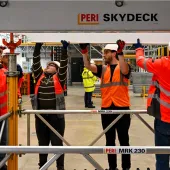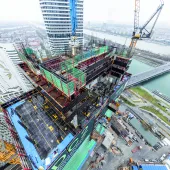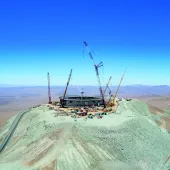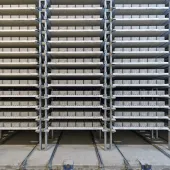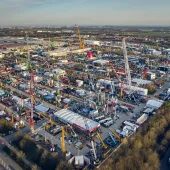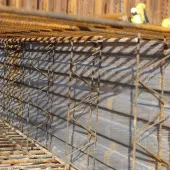Fehmarnbelt Tunnel reaches construction milestone
Construction of the Fehmarnbelt Tunnel, set to be the world's longest immersed tunnel upon completion, has achieved a significant milestone with all five production lines for standard tunnel elements now operational.
Spearheading this achievement is global formwork and scaffolding solutions provider, PERI.
Scheduled for completion in 2029, the Fehmarnbelt Tunnel aims to seamlessly connect Denmark and Germany, revolutionising travel with a swift seven-minute train journey or a mere ten-minute car ride between Scandinavia and Central Europe.
The tunnel spans an impressive 42m in width and encompasses five corridors: two for motor vehicles, two for rail traffic, and one as a service and escape passage. Key to its construction are the 79 standard tunnel elements, each an astounding 217m-long and weighing approximately 73,000 tonnes.
PERI's involvement is pivotal. The company engineered a bespoke formwork solution crucial for producing these mammoth tunnel segments. More than 11,000 tonnes of PERI formwork materials, meticulously manufactured across sites in Weißenhorn, Germany, Poland, and Italy, were transported to the construction site in Rødbyhavn via twelve ships and over 275 trucks, underscoring a meticulously planned logistics strategy to meet stringent deadlines.
"As the largest infrastructure endeavor in Northern Europe, the Fehmarnbelt Tunnel demands precision and reliability," said John Smith, PERI's project manager. "Our team's dedication and collaboration with FLC site personnel have ensured the seamless operation of all five production lines, critical for the tunnel's timely completion."
Already, numerous tunnel segments have been successfully concreted, each requiring around 3,300 cubic meters of concrete. The PERI formwork solution, tailored specifically for this project, has played a crucial role in these achievements.
In addition to formwork, PERI's comprehensive support extends to safety solutions. PERI UP scaffolding systems and PROKIT mesh barriers ensure secure access and fall protection throughout the production stages. Innovative InSite Construction pressure sensors monitor formwork pressures, maintaining compliance and efficiency during concrete casting.
"Our ongoing support ensures maximum operational capacity of the production lines," Smith affirmed. "Through close cooperation and regular maintenance, PERI remains committed to the successful realization of this transformative infrastructure project."
Construction process
The prefabricated sections of the Fehmarnbelt Tunnel are primarily made from reinforced concrete. Each segment is meticulously designed to fit together seamlessly, ensuring a watertight and structurally sound tunnel.
The tunnel sections are cast in controlled factory environments. This allows for precise quality control and optimal curing conditions for the concrete.
Once cured, the sections are transported to the construction site. Due to their large size and weight, specialized transportation methods, such as barges, are typically used.
At the construction site, the sections are immersed into the Fehmarn Belt. This involves lowering the segments into a trench on the seabed that has been prepared in advance.
Each segment is carefully aligned and joined to the preceding one. High-precision engineering ensures the joints are watertight. Rubber gaskets and grout are often used to seal the connections between segments.
Once all sections are in place and securely joined, the trench is backfilled with sand and gravel to stabilize the tunnel. Additional protective layers, such as rock armor, may be added to shield the tunnel from seabed movements and potential impacts from anchors or other objects.
The prefabricated, immersed tunnel approach combines the advantages of factory-controlled production with the robustness required for a major underwater infrastructure project, ensuring long-term durability and reliability of the Fehmarnbelt Tunnel.







